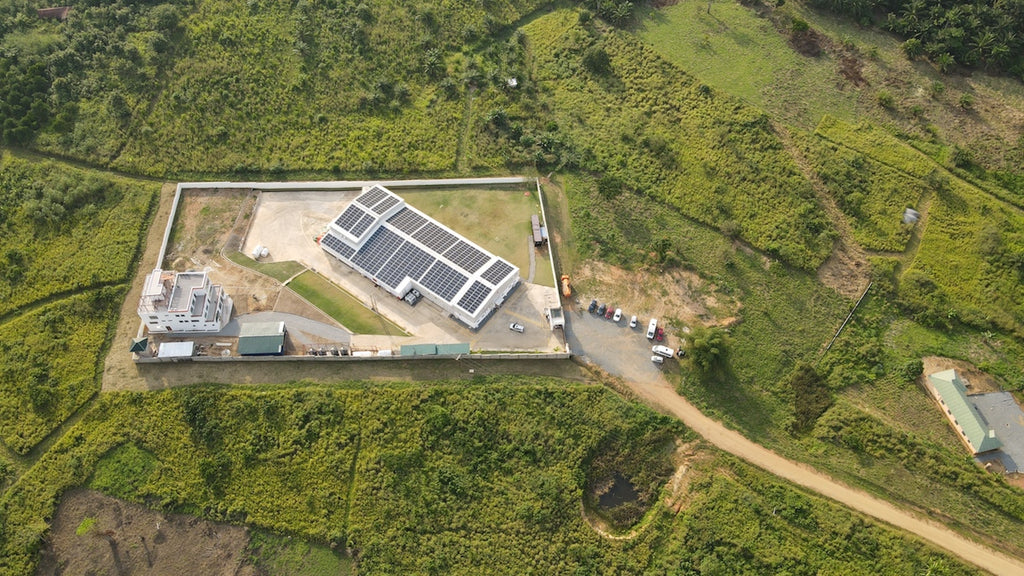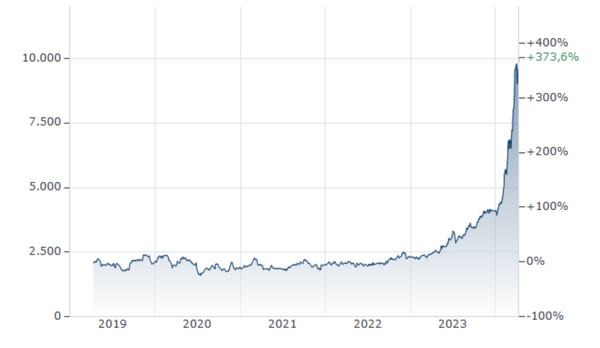The rise in cocoa prices and its consequences

The cocoa price increase and its background
Three years ago, we launched our pioneering mission to revolutionize the chocolate industry. Where there was still a green field in 2019, organic chocolate is now produced in West Africa's first chocolate factory. Each bar is produced using solar energy and packaged in compostable packaging. The result is a lighthouse project in the chocolate industry and already over 115 qualified, well-paid jobs. However, the currently particularly uncertain, highly volatile and extremely tense market environment is currently presenting us with a number of challenges. The market for organic chocolate bars will remain under pressure in 2024, while the global market price for cocoa has reached a historic all-time high.
In these uncertain times, it is more important than ever to continue to drive value creation and job creation in Ghana. Despite all our efforts, however, the dramatic increase of over 300% in the world market price means that we unfortunately have to implement a significant price increase in EIAs as of 01.05.24 in order to be able to withstand the high cost pressure. It should be noted that without the expansion of our partnership with WeltPartner, the increase would be even higher, as it creates additional synergy effects to further expand the joint impact and offer a better service.

Fig. 1: Drone image of the fairafric factory
Dramatic price developments on the global cocoa market
The raw material cocoa is traded on the stock exchange. In the past, the world market price for a ton of cocoa was usually between $1,500 (US dollars) and $2,200 per ton of cocoa. The world market price is to be understood as the base price and therefore also forms the basis for organic and fair trade cocoa, for which a fixed minimum premium is paid in addition to the base price, depending on the certification.
But the entire cocoa industry is currently upside down! The world market price for cocoa has more than tripled in the last 12 months alone (from $2,200 in March 23 to over $10,686 in April 24), with new historic highs still being reached every day. There has never been such a price increase on the cocoa market and of course this also affects our purchase prices.

Figure 2: Cocoa world market price in $ per ton, from 2019 to April 2024
Why is the world market price for cocoa currently rising so rapidly?
1. Rise in the cost of living The cost of living in West Africa has risen dramatically, particularly in the last two years. The war in Ukraine and the associated exploding energy prices have led to a currency crisis in Ghana, with the result that inflation has risen steadily to almost 70 percent in recent years. In line with our vision, we at fairafric have therefore significantly increased the wages of our employees, which hardly any other company in Ghana has done, so that the purchasing power of the people in the country has fallen sharply. This effect, together with last year's below-average harvest, led to an initial increase in the world market price for cocoa from GBP 1,800 in the first quarter of 2022 to GBP 2,700 in the summer of 2023 – one of the highest values in the history of the world market price for cocoa at that time.
2. Crop losses of up to 40-50% in West Africa
In hardly any other part of the world has climate change been as noticeable as in West Africa. While the rainy season is normally over when the cocoa harvest begins, last year it lasted throughout the entire cocoa harvest. It rained so heavily for 1-2 hours a day that it sometimes led to flooding, as the soil was unable to absorb the water, while the rest of the day was sunny and warm. One of the main reasons for these strong weather changes is a climate phenomenon called "El Niño", in which the ocean currents change due to the warming of the ocean. In addition to climatic changes, the so-called "black pot disease" has also led to crop losses. This is a fungal disease of the cocoa tree in which the cocoa pods turn black directly on the cocoa tree and fall off before they are even ripe. These changes have resulted in the 2023/2024 cocoa harvest being up to 40-50% lower than the previous year, although the 2022/2023 harvest was already below average. With every piece of news about the harvest volumes, the world market price continued to rise to GBP 3,600 in December 2023. We had recalculated our prices on this basis at the beginning of 2024, which led to our original plan to adjust the RRP by EUR 0.20 per bar. Unfortunately, however, the cost of cocoa has risen to unprecedented heights in record time since the beginning of the year.
3. Structural reasons for the rise in cocoa
Another key driver is the structural challenges of the cocoa market. Since the state concludes contracts directly with the major players in the cocoa sector via COCOBOD and has been heavily dependent on the inflow of foreign currency in recent years, larger quantities of cocoa have been sold than were available. This is not unusual in itself, as these contracts are delivered in the next harvest. However, it only works if the cocoa harvest increases or at least remains constant. As this harvest is significantly smaller, there has now been a crash, as the contracts from the past and regular demand are significantly higher than the amount of cocoa available. Significant price increases were the result.
4. Supply shortages & speculation
The chocolate industry has experienced unprecedented conditions (price trends and availability) on the cocoa market over the last 12 months. The first increase to GBP 2,700 in the summer of 2023 was already a shock for the industry. Most producers only bought small quantities at this price in the hope that it would only be a short-term effect. However, the price continued to rise due to further crop failures. Since the beginning of this year, the situation has escalated. Many manufacturers had to buy cocoa urgently to prevent production from coming to a standstill. The result: panic buying, where the price was secondary in order to secure production. This led to unexpected price jumps. Within a few weeks, the price per tonne rose from GBP 3,600 to currently over GBP 6,950. Many manufacturers of intermediate cocoa products (e.g. cocoa mass and cocoa butter) now only offer daily prices if they have enough cocoa available at all. Due to the significantly poorer harvest, there are currently major problems with the availability of cocoa and the first factories cannot get enough cocoa beans regardless of the prices.
As the global cocoa market price is determined on the stock exchange, speculation also has a major influence on the cocoa price. As soon as the first news of crop failures became public, speculators bet on further price rises and intensified the upward momentum, so that speculation now has a considerable influence on the sharp rise in prices.
Why it is important to continue supporting fairafric and our partners

Fig. 3: Cocoa farmers from West Africa
Our chocolate is not only a treat for the palate, but also a contribution to supporting a fair and sustainable cocoa industry. By buying our chocolates, you are helping to ensure that fair prices are paid to cocoa farmers, which in turn secures the livelihoods of many communities in Ghana. In addition, by creating local jobs, we promote economic development and help to build stable structures.
We very much hope that, despite this news, you will be just as motivated to buy and offer our chocolates and thus continue to contribute to offering young people in Ghana career prospects and making chocolate fairer.
Your great commitment will be even more important in the future. We want to support you in the best possible way and overcome this exceptional situation together with you – with transparency and close communication.
We thank you from the bottom of our hearts for your support on our path to a more sustainable future. Let's continue to make a difference together and stand up for a world where everyone deserves a fair chance.
Background information and frequently asked questions:
How is the cocoa trade structured?
One of the main reasons for the major challenges on the cocoa market is the historically grown structures with countless middlemen acting between cocoa farmers and chocolate buyers.
For example, the cocoa trade in Ghana is regulated by the state authority COCOBOD, which has a monopoly on the purchase and sale of Ghanaian cocoa beans. The beans are purchased from the farmers by COCOBOD-certified companies, so-called "Licensed Buying Companies" (LBC). The cocoa farmers in Ghana therefore sell their cocoa beans to LBCs, which then sell the cocoa beans on to COCOBOD. COCOBOD, in turn, has contracts for certain purchase quantities with traders, who then sell the cocoa beans to the industry. A few players dominate here, buying up almost 75% of the world's cocoa and thus wielding enormous market power: Nestlé, Mondelez, Barry Callebaut, Cargill, Olam.
How does fairafric deal with these structures?
The aim of fairafric is to put an end to the poverty of the people involved who live from cocoa in Ghana. That is why fairafric has built its chocolate factory directly in the cocoa-growing region in Ghana, so that the entire process from the cocoa tree to the finished chocolate bar is carried out locally. By being directly on site, real solutions and thus prospects for more and more people in Ghana can be created together with the surrounding communities and a structural change can be driven forward. At 600 dollars (equivalent to 475 British pounds) per tonne of cocoa beans, fairafric pays the highest organic premium in the whole of West Africa. This approach of fair prices for cocoa farmers and the aim of creating jobs in processing multiplies Ghana's income compared to the otherwise usual, pure export of cocoa beans for processing in Europe.
How can fairafric ensure traceability?
In practice, we purchase cocoa as follows:
- We inform the cocoa cooperative what quantities we need at what time during the harvest period.
- As soon as the required quantity has been harvested, we are informed by the cooperative.
- We personally accompany the purchasing process between COCOBOD and the partner cooperative on site. This enables us to ensure that we receive every cocoa bean that is destined for us.
- The price that we pay to the partner cooperative at the end of the purchasing process is calculated from the world market price per tonne of cocoa, the premium for cocoa beans from Ghana and the organic premium that we also pay. We pay the organic premium directly to the cocoa cooperative.









